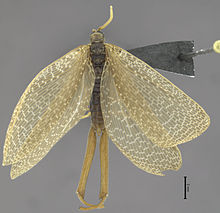| Meropeidae Temporal range: Middle Jurassic to Recent
| |
|---|---|

| |
| Merope tuber | |

| |
| Austromerope brasiliensis | |
| Scientific classification | |
| Domain: | Eukaryota |
| Kingdom: | Animalia |
| Phylum: | Arthropoda |
| Class: | Insecta |
| Order: | Mecoptera |
| Family: | Meropeidae Handlirsch 1906 |
| Genera | |
| |
Meropeidae is a family of tiny scorpionflies within the order Mecoptera with only three known living species, commonly referred to as "earwigflies" (or sometimes "forcepflies"), based on the earwig-like forceps-shaped male genitalia. The living species are the North American Merope tuber, the Western Australian Austromerope poultoni, and the recently discovered South American A. brasiliensis.[1] The biology of these species is essentially unknown, and their larvae have never been seen.[2] The adults have been suggested to probably be saprophagous, though they have never been observed feeding.[3] The fossil record of the group extends back to the Jurassic. The earliest known member is Boreomerope antiqua[4] known from an isolated wing found in the Middle Jurassic Itat Formation of Siberia. Other extinct genera include Burmomerope[5][6] with three species and Torvimerope with one species are both from the mid Cretaceous (Cenomanian) aged Burmese amber.[7] As such, the extant members of this family can be considered living fossils. These insects are also of interest due to their presumed basal position in the order Mecoptera. Thaumatomerope with four described species all from the Madygen Formation in Kyrgyzstan has historically sometimes been included within the family, it was placed into its own monotypic family, "Thaumatomeropidae." in 2002.[8]
The closest relatives of the family are thought to be Eomeropidae, another relictual family of mecopterans with only 1 living species whose fossil record also extends back to the Jurassic.[7] The family name was spelt "Meropidae" in old literature but this clashes with the homonymous family name in birds for bee-eaters. The spelling of Meropeidae was adopted for the insect family by the ICZN in Opinion 140 of 1943.[9]
Phylogeny after Zhang et al. 2023:[7]
| Meropeidae | |
- ^ Machado, R. J. P.; Kawada, R.; Rafael, J. A. (2013). "New continental record and new species of Austromerope (Mecoptera, Meropeidae) from Brazil". ZooKeys (269): 1–10. doi:10.3897/zookeys.269.4255. PMC 3592268. PMID 23653525.
- ^ Friedrich, F.; et al. (2013). "The head of Merope tuber (Meropeidae) and the phylogeny of Mecoptera (Hexapoda)". Arthropod Structure & Development. 42 (1): 69–88. doi:10.1016/j.asd.2012.09.006. PMID 23078868. Retrieved September 26, 2014.
- ^ Palmer, Christopher (2010). "Diversity of feeding strategies in adult Mecoptera". Terrestrial Arthropod Reviews. 3 (2): 111–128. doi:10.1163/187498310x519716. ISSN 1874-9828.
- ^ Novokschonov, Viktor (1995). "Der älteste Vertreter der Meropeidae (Mecoptera, Insecta)". Paläontologische Zeitschrift. 69 (1–2): 149–152. doi:10.1007/BF02985980. ISSN 0031-0220. S2CID 83279049.
- ^ Grimaldi, David A.; Michael S., Engel (2013). "The Relict Scorpionfly Family Meropeidae (Mecoptera) in Cretaceous Amber". Journal of the Kansas Entomological Society. 86 (3): 253–263. doi:10.2317/JKES130219.1. JSTOR 43288244. S2CID 84299772. Retrieved 2021-03-12.
- ^ Zhao, Xiangdong; Zhang, Qingqing; Jarzembowski, Edmund A.; Chen, Lei; Wang, Bo (November 2016). "A new earwigfly from mid-Cretaceous Burmese amber (Mecoptera: Meropeidae)". Cretaceous Research. 66: 136–140. doi:10.1016/j.cretres.2016.06.008. ISSN 0195-6671.
- ^ a b c Zhang, Yanjie; Labandeira, Conrad C.; Yu, Jiamiao; Shih, Chungkun; Ren, Dong; Gao, Taiping (2024-07-23). "Evolution and mandibular sexual dimorphism in mid‐Cretaceous scorpionflies (Insecta: Mecoptera: Meropeidae)". Journal of Systematics and Evolution. doi:10.1111/jse.13121. ISSN 1674-4918.
- ^ Wills, Allan (2007). "Earwig Flies? Ancient and Mysterious Insects". Western Wildlife. 12 (1): 5.
- ^ "Meropidae (Aves): Proposed amendment of entry in official list of family-group names in Zoology. ZN(S.)2286". Bulletin of Zoological Nomenclature. 36 (3): 154. 1979.